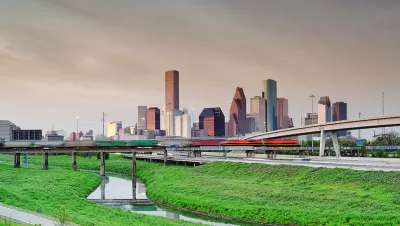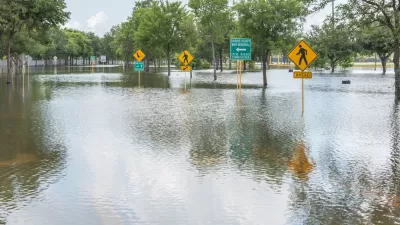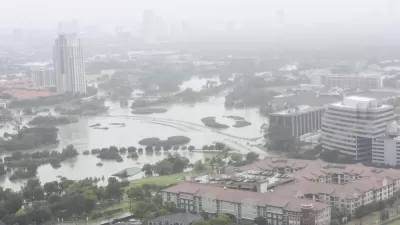History shows that there's more than one way to control flooding, but the best ideas are also urban amenities.

After Hurricane Harvey's destruction, but before money for rebuilding pours in, Jose Solis takes a page in the Houston Chronicle to consider how two cities responded to major floods in the fairly distant past.
"The histories of San Antonio and Los Angeles," Solis writes, "provide strong arguments for why design should play an essential role in developing new infrastructure and a cautionary tale for what happens when it is ignored."
Both Los Angeles and San Antonio experienced major flooding in the 1920s and '30s that brought a great deal of federal funding for major infrastructure to prevent future losses. Los Angeles, using a strategy typical of both the urbanism of the era and of the city itself, buried the Los Angeles River, replacing it with an effective but joyless concrete channel; San Antonio built Riverwalk, which works as a flood control device but also as an amenity for residents and a huge tourist draw.
History has been much kinder to Riverwalk, and Los Angeles is preparing to spend a great deal of money to remake the LA River into something more like it. (Houston's neighbor, New Orleans, also embraced the idea of amenity-as-flood-control after its own catastrophes.)
Solis praises New York City's post-Sandy Rebuild by Design competition as something that "evolved into a broader initiative for rebuilding cities to be more resilient" and suggests that Houston initiate something similar.
"Rebuild by Design," Solis continues, "provides a blueprint for how Houston can attract leading thinkers to develop solutions that will not only protect us during future floods, but let people enjoy living here for all the times between."
FULL STORY: As Houston rebuilds, we need amenities, not eyesores

Study: Maui’s Plan to Convert Vacation Rentals to Long-Term Housing Could Cause Nearly $1 Billion Economic Loss
The plan would reduce visitor accommodation by 25,% resulting in 1,900 jobs lost.

North Texas Transit Leaders Tout Benefits of TOD for Growing Region
At a summit focused on transit-oriented development, policymakers discussed how North Texas’ expanded light rail system can serve as a tool for economic growth.

Using Old Oil and Gas Wells for Green Energy Storage
Penn State researchers have found that repurposing abandoned oil and gas wells for geothermal-assisted compressed-air energy storage can boost efficiency, reduce environmental risks, and support clean energy and job transitions.

Private Donations Propel Early Restoration of Palisades Playground
Los Angeles has secured over $1.3 million in private funding to restore the Pacific Palisades playground months ahead of schedule, creating a modern, accessible space that supports community healing after recent wildfires.

From Blight to Benefit: Early Results From California’s Equitable Cleanup Program
The Equitable Community Revitalization Grant (ECRG) program is reshaping brownfield redevelopment by prioritizing projects in low-income and environmental justice communities, emphasizing equity, transparency, and community benefits.

Planting Relief: Tackling Las Vegas Heat One Tree at a Time
Nevada Plants, a Las Vegas-based nonprofit, is combating the city’s extreme urban heat by giving away trees to residents in underserved neighborhoods, promoting shade, sustainability, and community health.
Urban Design for Planners 1: Software Tools
This six-course series explores essential urban design concepts using open source software and equips planners with the tools they need to participate fully in the urban design process.
Planning for Universal Design
Learn the tools for implementing Universal Design in planning regulations.
Ascent Environmental
Borough of Carlisle
Institute for Housing and Urban Development Studies (IHS)
City of Grandview
Harvard GSD Executive Education
Toledo-Lucas County Plan Commissions
Salt Lake City
NYU Wagner Graduate School of Public Service





























